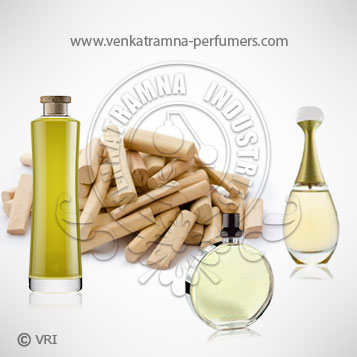
| Botanical Name | Santalum Album |
| Common Name | sandal |
| Country of Origin | India |
| Solubility | Insoluble in water, soluble in alcohol and oils |
| Specific Gravity | 0.97000 - 0.97800 @ 20 c |
| Optical Rotation | (-15) - (-20) |
| Refrective Index | 0.962 - 0.976 @ 30C |
| PlantPart | Wood |
| Bland With | Bergamot, Clary Sage, Lavender, Geranium, Jasmine, Neroli, Patchouli, Tea Tree, Rose, Lemon and Ylang-ylang. |
| CAS No | 8006-87-9 |
| Flash Point | 93.33 °C |
| Extraction Method | Steam Distillation |
Sandalwood is an evergreen, parasitic tree that burrows its roots into other trees and it can grow up to 9 meters (30 feet) high and has a brown-gray trunk, many smooth slender branches, leathery leaves and small pink-purple flowers. It can take thirty to sixty years for a tree to reach full maturity. That is when it can be harvested and distilled. The harvest is strictly controlled and the wood is usually sold at government auctions which makes its very expensive.
Sandalwood, the holiest of holies, the most sacred of trees, has been revered throughout the ages. Its heartwood produces a most valuable essential oil, widely sought after for incense, perfumery, cosmetics and aromatherapy. Sandalwood is sacred to Shiva. It stirs the root chakra and awakens the Kundalini snake. But what makes Sandalwood most special, is its use in tantric practice, where it is used to connect the lowest with the highest chakra, transmuting basic sexual energy into cosmic consciousness as it opens the third eye. Devout Hindus make a Sandalwood paste with which they anoint their 'Shiva eye'. Despite its gentle softness, Sandalwood has a male scent, which is structurally similar to a male pheromone that sends an unmistakable, yet barely perceptible, scented message to the opposite sex. This is why Sandalwood can be an effective aphrodisiac. Spiritually it is balancing and calming, a fragrant key to a meditative space dimension. Sandalwood is also said to protect against evil spirits. It is said that mean spirited people will not even be able to come close to it. Unfortunately, this belief has not proven to be true - mean spirited people do come close to it all the time. Illegal poachers, who couldn't care less and simply want to cash in on the very lucrative international market, lay axe on the tree and smuggle it to neighbouring countries that don't have export regulations. Under such circumstances enforcing regulations and safeguarding sustainable harvests becomes extremely difficult. Asia is by far the greatest market for Sandalwood products, it being used not only for incense and perfumery, but also for carving sacred artefacts and building shrines and temples. While it is possible to grow Sandalwood in other tropical regions, it appears that it looses its distinctive scent. If the wonderful gifts of this tree are to survive into the future, the Indian Government will have to get a lot more proactive to protect these trees.
Color : Yellow with Musky, Woody odor,
Aroma : Warm, sweet, slightly spicy
Class: Alcohol. Up to 90% santalol, santene, teresantol, borneol, santalone.
The oil has great application in perfumery and cosmetics. The oil is also used in making agarbatti’s for incense. No other wood is most closely tied to religion and spirituality than sandalwood. Apart from its spiritual and historical significance, sandalwood is also known for its extreme usefulness. Whether you use it for aromatherapy, for perfumery, for skin care, for treating illnesses or for incense. COMMON USAGE • Cosmetics • Perfumery • Soap Industry • Incense (Agarbatti’s) • Sedative • Antiseptic